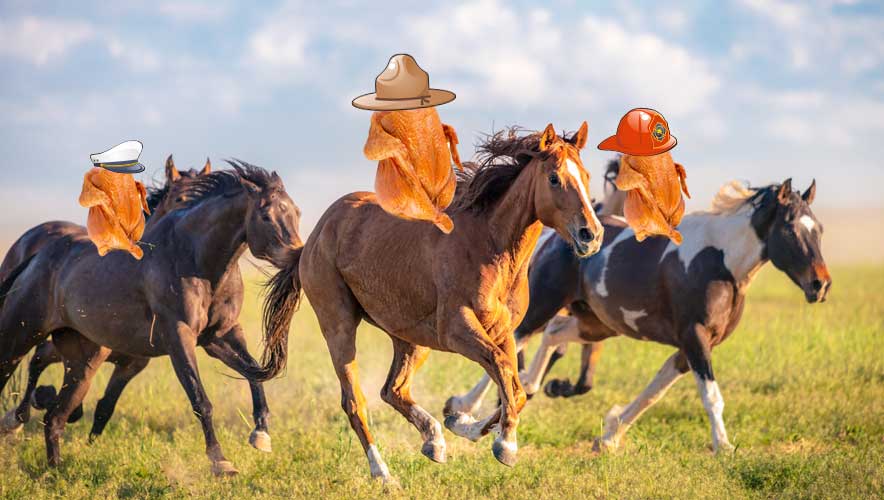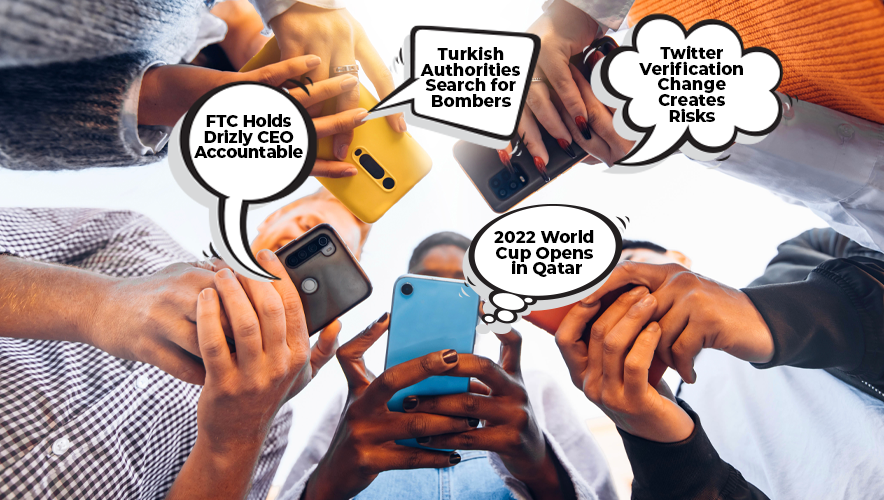Serious Fun: Using Social Media to Entertainingly Educate
Covering the security industry is serious business. Many of the topics that Security Management focuses on involve trauma, violence, and critical life-safety information. So, when I was prompted to write about social media, my editor told me to choose a topic I could have fun with.
With that encouragement, I sat down to make a list of who is relevant to the security community and having fun on the Internet? It was a short list, but at the top was the U.S. Consumer Product Safety Commission’s (CPSC) Twitter account.
If you’re not following the CPSC, you are missing out on a masterclass of memes, character narratives, and life-safety information that will make you smile—and double-check that your kitchen fire extinguisher is in working order this holiday season.
This social media mastery is due, largely, to the person behind the account—Joseph Galbo, the social media specialist at CPSC, who very kindly agreed to do an interview with Security Management to share his expertise and passion for creating engaging safety information.
Galbo joined the independent government agency six years ago following a role in the pharmaceutical industry. He now leads the effort to create graphics shared on social media based on the input of his colleagues—and a final sign off from his supervisors, the deputy and director of communications at CPSC.
“It’s a very small group, and one of the very fun things about it is getting a chance to have a very different tone of voice than a lot of government agencies,” Galbo says in a phone interview, adding that his opinions are his alone and not that of his employer. “I think one of the reasons we’re able to do that is because we’re so small; there’s just a lot less bureaucracy to go around and fewer people to convince that this is a good strategy.”
You can be a very serious organization and have a fun voice on social media.
During his interview process, CPSC officials told Galbo the goal for the Twitter account was to have a social media account that saved lives.
Originally, he was skeptical. But as engagement has gone up and interactions with the CPSC Twitter audience continue to rise, Galbo is no longer doubtful that the safety messaging is working—that regularly reiterating the little things, like checking that smoke detectors and fire alarms are working, that your carbon monoxide monitor is functioning, and that your fire extinguisher is ready for action, can result in a very big impact.
“We’re seeing really great results,” he says. “Whether it’s our engagements or anecdotal feedback about people buying batteries for their smoke alarms, changing their window blinds from corded to cordless, we’re seeing all the signs that this strategy is really working.”
The Mission
The CPSC has a unique mission. It works to save lives by reducing the “unreasonable risk of injuries and deaths associated with consumer products” by issuing and enforcing mandatory standards for products; obtaining product recalls and arranging for their repair, refund, or replacement; researching potential product hazards; and informing and educating consumers directly about product safety.
Social media plays a major role in carrying out CPSC’s mission. On CPSC’s Twitter account, for instance, each Thursday is devoted to product recalls while other days of the week feature product safety information—typically based on injury reports, a new threat, or an upcoming event.
One of the more challenging aspects that Galbo and his colleagues are up against when sharing safety information is that most people generally do not think that bad things will happen to them. Or if they do think about a safety hazard, it’s usually not something on the CPSC’s list.
“For example, I don’t think lawnmower injuries are super top of mind for folks. Same for people when it comes to something even more common, like home fires or carbon monoxide poisoning,” Galbo says. “Those are not things that you’re thinking about every day when you’re just going to work or trying to take care of your family, dealing with the day-to-day things that come up in life.”
Yet, as Galbo mentioned, those risks that are out of mind can be dangerous and have a real impact on Americans. For instance, the U.S. Centers for Disease Control and Prevention estimates that 430 people are killed and 50,000 people go to the emergency room each year because of carbon monoxide poisoning. Data analysis from LawnStarter estimates that more than 3 million people were injured by lawn or gardening equipment in the past decade—an average of 875 incidents per day.
The CPSC has insights into how products are injuring consumers because it maintains the National Electronic Injury Surveillance System—a system that receives reports from emergency rooms across the country, detailing the number of people injured and how they were injured.
“When we’re developing our safety messages, we’re using data directly from hospitals,” Galbo explains. “I’ll get those messages, I’ll get that data, and then I’ll have to start thinking through, ‘what is the product? How are people using it? How am I going to create something that people who use this product will find interesting or attractive or fun to look at?’”
A few years ago, for instance, a group of U.S. senators asked CPSC to turn its attention to beach umbrella safety because there were some serious injuries and one death related to their use. So, Galbo used the above process to think about who’s typically using beach umbrellas (people on vacation or people who live near a beach) and what imagery could be eye catching enough to encourage people to stick around to read the safety message?
The thought process resulted in messaging rolled out in 2019 to encourage the CPSC Twitter audience to make sure beach umbrella stands are properly placed. The messaging used a side-by-side meme photo telling onlookers to bury the past—and their beach umbrella.
Make sure your beach umbrella is at least 2 feet into the sand and angled into the wind #FridayFeeling pic.twitter.com/ZB25xT7zgM
— US Consumer Product Safety Commission (@USCPSC) June 28, 2019
The CPSC did it again in 2022 with an eye-catching meme of beach umbrellas captioned with the stark reminder that, yes, they can be deadly if not anchored properly in the sand.
If you're headed to the beach this summer, make sure your beach umbrella is buried into the sand, anchored, and tilted into the wind. pic.twitter.com/G6uTKGCHMB
— US Consumer Product Safety Commission (@USCPSC) August 16, 2022
The Style
To help bring those risks to mind and educate consumers, the CPSC uses a social media strategy that focuses on getting people’s attention by using an unconventional approach: memes, characters, and basic safety information.
“We stumbled into this very ridiculous meme-style of messaging initially because we didn’t have someone who could spend time creating social media graphics here at the agency—so I had to learn to photoshop to do them myself,” Galbo explains. “We accidentally ended up with these meme-style poorly designed graphics just because I was making them myself and I had no prior graphic design experience.”
To make the memes more “emotionally engaging” for the CPSC audience, Galbo says they began experimenting with different characters that are “almost a parody of classic government spokesperson characters” that would make people laugh—while also learning about safety.
There’s Handsome Ron, the friendly bird wearing a red hat, reminding consumers to double-check their smoke alarms during the daylight saving time switch. There’s Potato the Dog with the heads-up that space heaters do, in fact, need space to operate safely. There’s Quinn, the Quarantine Fox, encouraging people to be kind to each other and wear face masks properly over their mouth and nose. There’s Trent the Turkey, reminding consumers to “stand by their pan” to prevent kitchen fires while preparing their holiday feasts. And there’s Copernicus Jackson, a particularly fluffy cat, sharing Halloween safety tips to ensure you and your trick-or-treat party don’t get separated—or hit by a car—while making your candy runs.
While the initial character list included animals that many people tend to like—cats and dogs—Galbo (who declined to say which character is his personal favorite) has found that some of the more obscure characters have really garnered a following.
“We just shared a graphic this past safety month; it’s a giant tarantula in a baby’s crib,” he says. “It’s a little horrifying in a lot of ways, but people really liked it. The spider doesn’t even have a name. But people were super drawn to the graphic, and we got some really positive feedback on that.”
This Baby Safety Month, learn how to keep your baby safe while they sleep. Never put pillows, blankets, or toys in a sleep space. Always lay your baby down to sleep on their back - every time #BSM2022 pic.twitter.com/IvHL2CFGJz
— US Consumer Product Safety Commission (@USCPSC) September 21, 2022
The same could be said for an enchanted scorpion that makes an appearance around the holiday season to remind people to purchase safe presents for kids. There’s also a giant skeleton walking out of a Christmas tree that’s on fire—a regular reminder to water your real Christmas tree lest it ruin your holiday by going up in flames.
Surprise! pic.twitter.com/MbTOHj1uRd
— US Consumer Product Safety Commission (@USCPSC) December 5, 2021
“The strategy is very simple in that we’re trying to create things that people have never seen before,” Galbo says, with the idea that CPSC is providing “people unexpected content that surprises them, entertains them, and delights them. That’s something that most brands are doing on social media these days. I think it still feels very novel and very new to see it from a federal agency.”
Adaptation
The CPSC Twitter account has been using a similar style and character roster for the past several years since it continues to resonate with its audience—i.e., the American public. But because new products come on the market and safety hazards evolve, the social media strategy changes a bit to incorporate these new threats.
For instance, new messaging from CPSC has focused on micro-mobility devices like e-scooters and lithium-ion battery-powered devices like hoverboards.
Galbo also says he consumes a lot of pop culture—TV, movies, and music in multiple genres—to ensure CPSC content is relevant to societal interests.
“It’s a lot of keeping your ear to the ground on what’s happening in pop culture,” he says. “It’s trying to understand different people and where they’re coming from. That’s one of my favorite parts of the job—the expectation that you’re creating things that are meant to appeal to all Americans and from all different backgrounds.”
One example of this is earlier in 2022 when corn was having a major social media moment. Corn Kid, Tariq, went viral after giving an interview with the Web series “Recess Therapy” about why he loves corn. (Spoiler: Because it has the juice, duh.)
The CPSC Twitter account took note, debuting “Mega Corn” with a reminder to always wear a helmet when riding an all-terrain vehicle (ATV)
Always wear a helmet when riding your ATV through the corn. pic.twitter.com/8VRyaaIgRt
— US Consumer Product Safety Commission (@USCPSC) August 29, 2022
“The art of it for us is finding a way into those conversations where, again, safety is not always the most obvious thing because most people online are not talking about consumer product safety—outside of a major crisis which may happen once or twice a year,” he adds.
The CPSC has also worked since 2021 to incorporate diversity, equity, and inclusion into its messaging strategy, which resulted in crafting internal guidelines about how to use social media to ensure its representative of all the audiences the commission is trying to reach.
“Not using AAVE—African American Vernacular English—and not appropriating” cultural elements are included in the strategy, Galbo says. “That’s become very important for us, I think, because what you see a lot of brands do is appropriate at times, and we certainly never want to be accused of that or find ourselves doing that just for the sake of trying to get the message out there.”
For security practitioners who are thinking of embarking on their own social media communication journey, Galbo says the approach CPSC has used to create engaging content can work for them too. Taking the extra time to create something that is written and displayed in a way that people can easily understand the message that also has some entertainment value or adds unexpected joy goes a long way in effective communication.
“One thing we’ve proven over here is that you can be a very serious organization and have a fun voice on social media—or an unconventional voice on social media that does not diminish the serious work you are doing,” Galbo says. “If anything, from the feedback I’ve seen from people whether it’s anecdotally or our follower numbers, in a lot of ways it helps people respect the agency’s work even more. I think displaying a sense of humor especially conveys a sense of confidence in oneself.”
Megan Gates is senior editor at Security Management. Connect with her at [email protected]. Follow her on Twitter: @mgngates.








